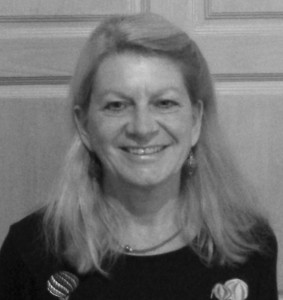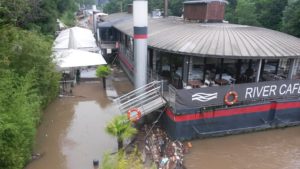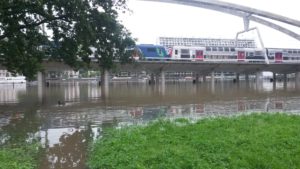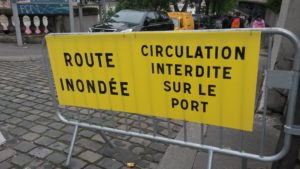09 June 2016
Paris in Springtime
This isn’t the Paris I remember!
by Lynda Goetz
 Grey, wet and cold. It wasn’t supposed to be like this! Not that it was a romantic weekend or anything, but a weekend in Paris at the beginning of June should, I felt, have been a little less dismal. Some thirty years ago I used to spend pretty much every other weekend in Paris. I would join the regular commuters on the Friday evening flight and we would smile wryly at each other as we got to recognise familiar faces. We would queue up to ‘bag’ the best seats at the front (seats were not allocated and it was very much ‘first come first served’) so that we could leap out at the other end, armed as we were with nothing more than hand-luggage– in the days when that meant pretty much exactly that, not small suitcases which rumble behind you like over-faithful dogs – to start our Paris weekend as soon as possible. In those days it was all quite romantic and the discovery of enchanting restaurants, small museums and the atmosphere of different ‘quartiers’ was an eye-opening joy. Paris was very different from London. The Seine was far more a part of Paris than the Thames, at that time, was a part of London. The Seine was accessible. You could walk along the quaysides right by the river. In summer for a month in late July and August the authorities even imported sand to create artificial beaches for the populace to enjoy, although swimming has been prohibited since 1923. This still happens and a pledge was made last year by the Mayor, Anne Hidalgo, that the Seine will be clean enough to swim in by 2024 (although the same pledge was made by former president Jacques Chirac in 1988, who said it would be ready by 1994).
Grey, wet and cold. It wasn’t supposed to be like this! Not that it was a romantic weekend or anything, but a weekend in Paris at the beginning of June should, I felt, have been a little less dismal. Some thirty years ago I used to spend pretty much every other weekend in Paris. I would join the regular commuters on the Friday evening flight and we would smile wryly at each other as we got to recognise familiar faces. We would queue up to ‘bag’ the best seats at the front (seats were not allocated and it was very much ‘first come first served’) so that we could leap out at the other end, armed as we were with nothing more than hand-luggage– in the days when that meant pretty much exactly that, not small suitcases which rumble behind you like over-faithful dogs – to start our Paris weekend as soon as possible. In those days it was all quite romantic and the discovery of enchanting restaurants, small museums and the atmosphere of different ‘quartiers’ was an eye-opening joy. Paris was very different from London. The Seine was far more a part of Paris than the Thames, at that time, was a part of London. The Seine was accessible. You could walk along the quaysides right by the river. In summer for a month in late July and August the authorities even imported sand to create artificial beaches for the populace to enjoy, although swimming has been prohibited since 1923. This still happens and a pledge was made last year by the Mayor, Anne Hidalgo, that the Seine will be clean enough to swim in by 2024 (although the same pledge was made by former president Jacques Chirac in 1988, who said it would be ready by 1994).
 Last weekend, however, that possibility was not only remote, it seemed laughable, as a brown, muddy Seine swirled under the bridges carrying with it sticks, logs and rubbish of all descriptions. The water gushed and eddied round the buttresses at a speed that would have made any attempt at swimming positively dangerous, even if it had had any kind of appeal whatsoever under the lowering skies. The benighted inhabitants of the famous houseboats, normally accessible by small ladders from the quaysides, became the subjects of photos and videos (and cheers) as they struggled against the current to row or paddle across to their homes. Many were clearly keen to avoid a repeat of the experience as they tied lines on which they would, in future, be able to pull themselves across.
Last weekend, however, that possibility was not only remote, it seemed laughable, as a brown, muddy Seine swirled under the bridges carrying with it sticks, logs and rubbish of all descriptions. The water gushed and eddied round the buttresses at a speed that would have made any attempt at swimming positively dangerous, even if it had had any kind of appeal whatsoever under the lowering skies. The benighted inhabitants of the famous houseboats, normally accessible by small ladders from the quaysides, became the subjects of photos and videos (and cheers) as they struggled against the current to row or paddle across to their homes. Many were clearly keen to avoid a repeat of the experience as they tied lines on which they would, in future, be able to pull themselves across.
Gazebos and other tented terrace areas lay forlornly under water where only days previously they had welcomed tourists and residents at quayside bars and restaurants. Potted trees and shrubs poked the tips of their branches above the dirty water; whilst around them more detritus lay banked up in corners and dead-ends, deposited by the churning river. The ‘navettes’, which normally ply their trade for river tours, were firmly tied up in areas which had once been quays, but were now nearly a quarter of the way across the river. None of them could get under the picturesque bridges. The ‘BigBus’ tours were doing a roaring trade. Where formerly there had been quaysides for strolling or for parking your car perhaps if you were a boat owner, there was water. If you were lucky and your car had been parked on a slope or you had had the chance to move it, then that was perhaps one less worry. Some had not been so lucky and cars that had not been moved in time were submerged – just the sun roof visible. In one area, several cars including a rather lovely old Rolls Royce were parked, somewhat intriguingly, on the river side of a flood barrier, firmly, very firmly fixed in place. That seemed to excite the mobile phone photo snappers.
 I began to feel something of the angst a ‘rooky’ war photographer must feel. Should one really be photographing all this misery and chaos? A snap for Instagram? An ‘I was here’ photo to send to your WhatsApp group? Well, there is no doubt it is all interesting and newsworthy and of course many of the other usual tourist activities were not available. Fear of basement flooding meant the Louvre was closed, as was the Musée d’Orsay and Le Grand Palais. We didn’t check the Orangerie, although the ‘Jardins, Jardins’ garden show, right beside it in the Jardins des Tuileries, was very much open, in spite of the sogginess underfoot. This is a very small, very pale imitation of Chelsea, but was nevertheless quite fun as it was uncrowded and the exhibitors, not being Parisians, were friendly.
I began to feel something of the angst a ‘rooky’ war photographer must feel. Should one really be photographing all this misery and chaos? A snap for Instagram? An ‘I was here’ photo to send to your WhatsApp group? Well, there is no doubt it is all interesting and newsworthy and of course many of the other usual tourist activities were not available. Fear of basement flooding meant the Louvre was closed, as was the Musée d’Orsay and Le Grand Palais. We didn’t check the Orangerie, although the ‘Jardins, Jardins’ garden show, right beside it in the Jardins des Tuileries, was very much open, in spite of the sogginess underfoot. This is a very small, very pale imitation of Chelsea, but was nevertheless quite fun as it was uncrowded and the exhibitors, not being Parisians, were friendly.
This brings me on to my next thought about Paris. I have always been a French speaker and a Francophile (not a ‘little Englander’, Mr Cameron, in spite of my pro-Brexit stance) but I have never quite been able to summon up any fondness for the Parisians. I love their city, but the people I find grumpy, intolerant, xenophobic and generally difficult. Londoners (and I have been one) do tend to feel that London is a Very Important Place. Parisians however seem convinced that Paris is not only the capital of France, but the centre of the universe. That attitude doesn’t seem to have changed much in the intervening decades, although what has is the actual population of Paris. On a couple of fairly brief recent visits I got the impression that, apart from the increase in international tourism, which means that at the tourist venues one is seeing a much more varied tourist population, there is also a huge increase in the foreign resident population. Statistics apparently back up this impression, confirming that after falling for nearly 40 years, the population of Paris has risen steadily since 1999. According to Eurostat, the EU statistical agency, the Commune of Paris was the most densely populated city in the EU in 2012, with 21,616 people per square kilometre, compared with London’s Inner West area with only half that number at 10,374.
This dense population is noticeable on public transport. The Metro seems permanently crowded, even quite late at night. London, I know, is not that dissimilar these days. What is slightly more disturbing however, is something I certainly do not remember from thirty years ago (and maybe that was those rose-tinted spectacles), namely the number of beggars and ‘performers’ on the tubes themselves. Most Parisians seem to ignore them, but many look visibly uncomfortable as these down-at-heel people, mainly immigrants, launch into their routines, sometimes musical, sometimes simply recitations of their misfortunes which have led them to this pitch. I vividly still remember the discomfort I used to feel when I lived in Seville and the gipsies used to come into the bars with babes in arms. How to refuse to give when one is clearly spending money in a totally self-indulgent manner? At least on a train one does not have that guilt, but there is no doubt the whole issue is a difficult one. The Paris authorities do not seem to address this and it adds to the feeling of a city in crisis.
 On the way to our hotel in the taxi the traffic was dire. Admittedly it was rush hour, but according to our taxi driver this was not unusual for any time of the day. In spite of his well-honed lane-changing skills, our journey from the airport took well over an hour. Paris, he told us, needed a radical solution to its traffic problems. Apart from the impossibility of getting about the pollution, particularly on hot days, is serious. He dismissed as risible and gimmicky the solution used in 2014 of allowing cars with even number plates to use the roads on one day and cars with odd number plates the next. He seemed to support the idea raised very recently by our transport minister, Patrick McLoughlin, of hitting diesel-car owners ‘in the pocket’ and considered that taxis would probably be hybrid vehicles within a few years. Just in case you were wondering, the reason we got a taxi in the middle of rush hour was not stupidity, but the fact that a suspect package (‘un colis suspect’) in the airport led to the area where one purchases train tickets being closed off. Apparently that too is a frequent problem these days.
On the way to our hotel in the taxi the traffic was dire. Admittedly it was rush hour, but according to our taxi driver this was not unusual for any time of the day. In spite of his well-honed lane-changing skills, our journey from the airport took well over an hour. Paris, he told us, needed a radical solution to its traffic problems. Apart from the impossibility of getting about the pollution, particularly on hot days, is serious. He dismissed as risible and gimmicky the solution used in 2014 of allowing cars with even number plates to use the roads on one day and cars with odd number plates the next. He seemed to support the idea raised very recently by our transport minister, Patrick McLoughlin, of hitting diesel-car owners ‘in the pocket’ and considered that taxis would probably be hybrid vehicles within a few years. Just in case you were wondering, the reason we got a taxi in the middle of rush hour was not stupidity, but the fact that a suspect package (‘un colis suspect’) in the airport led to the area where one purchases train tickets being closed off. Apparently that too is a frequent problem these days.
On our return to the airport on Sunday, our plan to use the RER B was foiled once again; this time by a combination of the strikes, causing cancellation of 1 in 4 of the timetabled trains and an electrical failure (‘une panne electrique’)- hence the need, yet again, for a taxi. The rest of the time we walked and used the Metro. Walking, I regretted not having brought a stout pair of winter walking boots. I love the cobbled streets and the fact that in so many places Paris has kept these. I do not love the air of faint neglect which pervades many of the arrondissements, the weeds growing up through the uneven pavements and the building work which seems to be ongoing and intrusive. In the Metro I am puzzled by a pass system which runs from Monday to Sunday and means you cannot load up your ‘Navigo’ pass simply for a week from any date and staff who not only do not understand why you find this odd, but can then annul your pass but not give you a refund (you have to complete a form and return it to some office which may or may not choose to refund what you have paid). As if this isn’t bad enough they are rude and angry as if you have somehow offended them personally. Just as well I am not Japanese or I might have suffered from Paris Syndrome. Paris Syndrome, in case you, like me, had not heard of it, is a psychiatric breakdown, suffered by up to a dozen Japanese tourists a year, when their idealistic and romantic image of Paris fails to live up to expectations. When they encounter the reality the culture shock can be so severe that they may even need to be repatriated (http://news.bbc.co.uk/1/hi/6197921.stm). Worth a pause for thought as I step off the plane, carrying the jacket I have been wearing for 3 days, into the balmy embrace of a warm Devon evening.
If you enjoyed this article please share it using the buttons above.
Please click here if you would like a weekly email on publication of the Shaw Sheet

